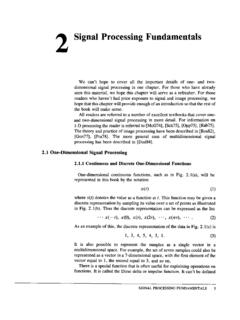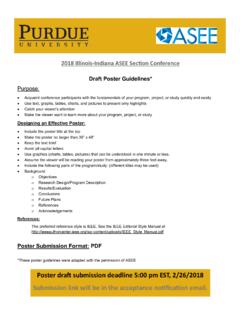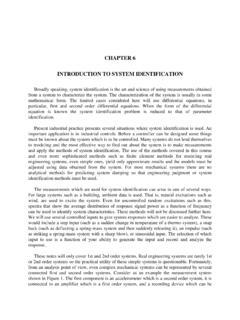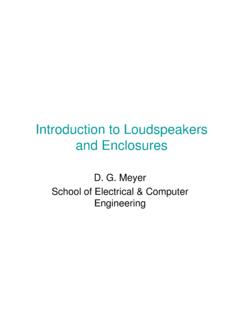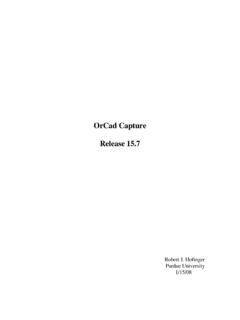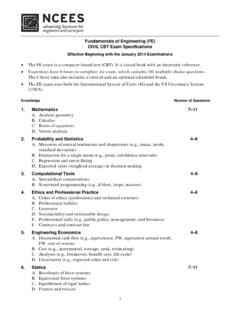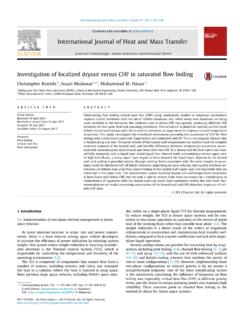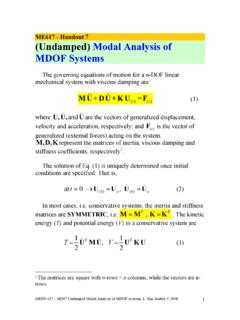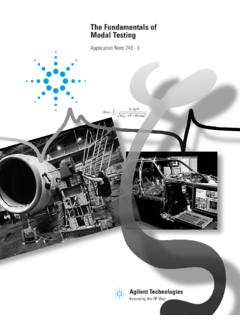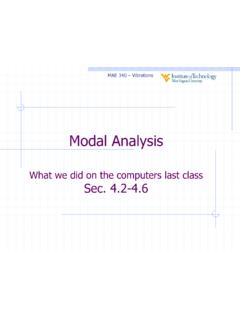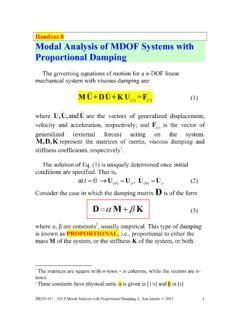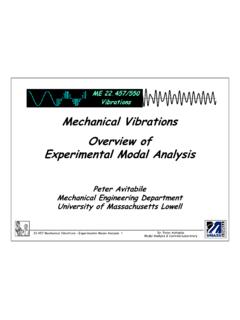Transcription of Response of MDOF structures to ground motion
1 1 Response of MDOF structures to ground motion ()()()1()gMxtC xtK xtMx t If damping is well-behaving, or can be approximated using equivalent viscous damping, we can decouple the equations of motion using modal decomposition: 1212()()()()Nqtqtxtqt ()Nqt and separate the system into its natural ()()()1()gMxtC xtK xtMx t becomesbecomes ()()()1()1, 2 ,,TTT TiiiiiiiiiigMqtCqtKqtMx tiN Tor when normalized with respect to modal mass TiiM 2() 2()()()1,2, ,iiiiii igqtwqt wqtx tiN 2() 2()()()1,2, ,iiiiii igqtwqt wqtx tiN 1TM where , called modal participation factorfor mode i. 1iiTiiMM 11 NTjjiijmM 21iTNiijjijMm 32() 2()()()1,2, ,iiiiii igqtwqt wqtx tiN For a lightly damped (underdamped) system that is initially at restFor a lightly damped (underdamped) system that is initially at rest, solution can be found using the convolution/Duhamel s integral from(),,0()( )sin()iitwtiigdidiqtx ew t dw Or using a numerical solution algorithm, once you compute you can find the contribution of the i-th mode to the Response of the structure .
2 ()iqtContribution of the i-th mode to the displacement at the j-th floor:()jxtUsing the modal Response , we can find various responses in each mode.()()1,2, ,jiji ixtqt jN jInterstory drift, story distortion, in story jis given by the difference of displacements of the floor above and floor below:(1)()()()jijijitxtx t 4To find internal forces (story shears, moments, etc.) associated with deformations convenient, we can introduce the concept of equivalent lateral lateral forces are external forces Fwhich, if applied as static forces would cause structural displacementsxstatic forces, would cause structural displacements any instant of time, the equivalent lateral forces associated with displacements due to contribution by mode i: 12()()()iiFtFtFt ()()()()iNiiiFtFtFtKxt undampedSimilarly, we can use inertial forces to find the equivalent lateral forces: 11()()()()1()()()absiiNNabsgiiiigiiFtM x txtxt xtqtxt see next pagethe velocity term is at least an order of magnitude smaller than the displacement term, and as such, neglected.
3 2222()()()( 2()())()()()()()absiiiigiiiiiiabsiiiiiii iiiixtqtxtwqtwqtxt w qtFtM wqtw Mqt 2211111222222222()()()()()()()()()()iiii iiiiiiiiiNiiNNiiiNNiwm q twmx tFtFtwm q twmx tFtFtwmq twm x t 5 ()()[]()[]()[]()[]()()TTTiiiiiTixtqtMxtM qtMq tMxt () 1()[][]1if ( )1 ( )[]iTiiTiiiTxtiiqtMMxtq tM 1211 NiiiN the equivalent lateral force at the j-th floor can be found fromt(),,0()( )sin()iitwtiigdidiqtx ew t dw AsInternal forces can be determined by static analysis of the lddbhil llf()2,,0()( )sin()iitwtijiij jigd idiFtwmxewtdw structure loaded by the equivalent lateral shearat j-th story due to Response in i-th mode may be calculated by summing the modal inertial forces above and at story j :()()NjikikjVtFt Total shear force at the foundation level( base shear ) due to Response in i-th mode:01()()NijijVtFt Total overturning moment at the foundation level( base overturning moment ) due to Response in i-th mode:01()()NijijjMtFth jh: elev.
4 Of story jabove the baseWe can write the base shear for i-th mode as 20111()()()NNNijijjiijjiejjjVtFtmxtwmx ()20,1,02()0,,02()()( )sin()()1( )sin()1()1( )sin()iiiiiitNwtiiijjigdijditTwtiiiigdid iTtiTwtiVtwmx ew t dwwVtMx ew t dwMwVtMx ew t d 0,,0()1( )sin()iigdiTdiiiVtMx ew t dwM 111 TTTTiiiMM M But7 22()0,,021()( )sin()iiTtiwtiigdiTdiiiMwVtx ew t dwM 221()0,2,01()( )sin()iiNjijtjwtiigdiNdijjijmwVtx ew t dwm 2N The term 121 NjijjNjjijmm is called the effective modal mass of mode i. The overturning base moment for i-th mode could be written asT01()()NijijjMtFth 2()0,1,01()( )sin()iiTtNiwtiijjjigdiTjdiiiMwMthmxewtd wM 8()()NNjijjjjiFt hhmMt iiimode mode mode Base Overturning MomentEquivalent Height=Base Shear110,011()()()jjjjjjjiequiv iNNijijjijjMthVtFtm ,equiv ih 212 NjijjNm Effective modal mass of mode i= 1jjijm 10,0()()
5 Njjjijiequiv iNihmMthVtm 01ijjijm 9 BuildingMode 1 Mode 2 Mode 3 Mode 4 Mode 5 Mode 6 Mode 7 Mode 8 Mode 9 Mode 10 Effective modal modal modal Mass0910070011-Story2-StoryEffective modal modal modal modal modal modal modal modal total Response of the structure is obtained by combining the modal responses in all the modes of displacement at the j-th floor, the lateral force at the j-th floor, the base shear, and the base moment are given byN11()()()()()()NjjiiNjjiiNxtxtFtFtVtV t 001001()()()()iiNiiVtV tMtMt 10 modal DECOMPOSITION APPROACH TO ANALYSE BASE-EXCITED STRUCTURESThe Response of an idealized multistory building to earthquake ground motion can be computed by the following procedure: 1. Find the ground acceleration. 2 Dfihli2. Define the structural properties:a.
6 Compute mass and stiffness distribution ( [M] and [K]) b. Estimate modal damping ratios. 3. Find natural frequencies 12,,,Nwww and modeshapes 12,,,N of vibration ( solve the eigenvalue problem). 4. Compute the Response of individual modes of vibration by repeating the following steps for each mode: a. Compute the modal Response ()iqtby numerical evaluation of the Duhamel integralDuhamel Compute the floor displacements. c. Compute story drifts from the floor displacements. d. Compute the equivalent lateral forces. e. Compute internal forces story shears and moments by static analysis of the structure subject to the equivalent forces. 5. Determine the total value of any Response quantity by combining the modal contributions that Response quantity. Examples11T1= secT2= secT3= sec3 Total wt=900 kip1213 El Centro 5/18/1940 EQ ground motion NS component.
7 The length of the record is 30 sec. 14 Use the Response records to compute inertia forces developed in the : Inertial forces that develop in the structure during 1st mode Response .15 Distribution of the modal inertial forces follow the respective modeshapeDistribution of shear forces in the structure for the first three modes: 16 modal base shear demand 17 Question: Is there an easier way to estimate maximum Response ?YES!use Response spectrause Response spectra(),,,0()( )sin()(, , , )iitwtiiigdiigiididiqtx ew t dWtxwww ()t (),0(, , , )( )sin()iiwtigiigdiWtxwx ew t d For lightly damped structures , so we can approximate ,diiww ()(, , , )iiigiiiqtWtxww where 11()() ()(, , , ) ()NNiiiigiiiiiixtqttWtxwtw For example, displacements are18 Interested in the maxima the absolute maximum quantities, such as peak displacement, peak interstory drift (story distortion), and : Maximum displacement of floor j.
8 We find the maximum story displacement for each story and in each mode. Say, we want to find, the displacement of j-th story due to Response in i-th mode.()jixt()()jiji ixtqt maxmaxmax( )max( )( )max( ,, ,)ijijijiijiiji igiitttixxtqtq tWtx ww 1max( ,, ,)( ,|)igiiiigtiWtxwSDTxw The maximum displacement (relative to ground ) of a single-degree-of-freedom systemwith period iTand damping ratio i when excited with the given ground motion . gx maxmaxmax( )max( )( )max()ixxt qtqtWtxw max(, | )jijiiiigxSD Tx max( )max( )( )max(,,,)jijijiijiiji igiitttixxt qtqtWtxww How do we find total Response ?How do we find total Response ?1912()()()()jj jjNxtxtxtxt max12max( )( )( )jjj jNtxxt x tx t 1212max( )( )( )max( )max( )max( )jjjNjjjNttttxtxtxtxtxtxt maxmax1211max( )max( )max( )max( )NNjjjjNjijittttiixxtx tx txtx Absolute Sumapproach (Absolute combination) 2maxmax1 Njjiixx Square-root of Sum of Squares(SRSS) combination(1)()()()jijijitxtx t 1()()Njjiitt 2maxmax1()Njjiit CAUTION: When you want to combine the effects of the modes to estimate a reasonable value for the maximum of a Response parameter (story displacement, interstory drift, story pp(ypyyforce, etc.))
9 , you need to find value of the Response parameter for each mode and then combine using any of the combination rules. Do not use already-combined Response parameters(say, story displacement estimates that considered contributions from all modes) to estimate other Response parameters (say, story forces); such an approach will result in erroneous estimates. 20 22()0,,021()( )sin()iiTtiwtiigdiTdiiiMwVtx ew t dwM Base shear 2(),01()sin( )iiTtiwtigdiTiiMwx ew t dM 2max001max( )max( ,, ,)TiiiiiiiTMVVtwWtxw 00max( )max( ,, ,)iiiigiiTttiiVVtwWtxwM max( ,, ,)( ,|)iigiiiigtwWtxwPSATx 2max01(, | )TiiiigTiiMVPSATxM max0 Effective modal mass( ,|)iiiigVPSATx How do we find total base shear? 22maxmax0011effective modal mass( ,|)NNiiigiiiVVPSATx 21 Example: 7-story buildingThe spectral displacement values at the first four periods of our 7-story structure are068sec443inTS inddddTSTSTSTS x in= inqSDqqq inddddTS qTS qTS qTS q maxmax7171 1maxmax7272 2maxmax7373 3( of the first-mode Response .)
10 ( of the first-mode Response .) x in in uququq Roof displacementNote that these maxima match the maxima in the corresponding Response histories. 23maxmaxmaxmaxmaxmaxmaxmax7 inu uuuuuuu Absolute Sum approach (Absolute combination)Roof total displacement estimate 2222222maxmaxmaxmaxmaxmaxmaxmax7 inuuuuuuuu Square-root of Sum of Squares (SRSS) combinationRule of thumb: Maximum displacement at the roof is ~ times the spectral displacement of the fundamental like for frame and for shearwall Shear Force max0 Effective modal Mass( ,|)iiigiVPSATx 25 ModeEffective modal Mass(kip-sec2/ft)Effective Weight(kip)Period(sec)Spectral Pseudo-Acceleration, SA(g) : 700 kip kip (9% of first-mode Response ) kip (3% of first-mode Response )VgVgVg 03max04p(p) kip gVg (1% of first-mode Response )Absolute Sum approach (Absolute combination)max0658 kipV Square-root of Sum of Squares (SRSS) combinationmax0584 kipV 26 modal base shear demand
